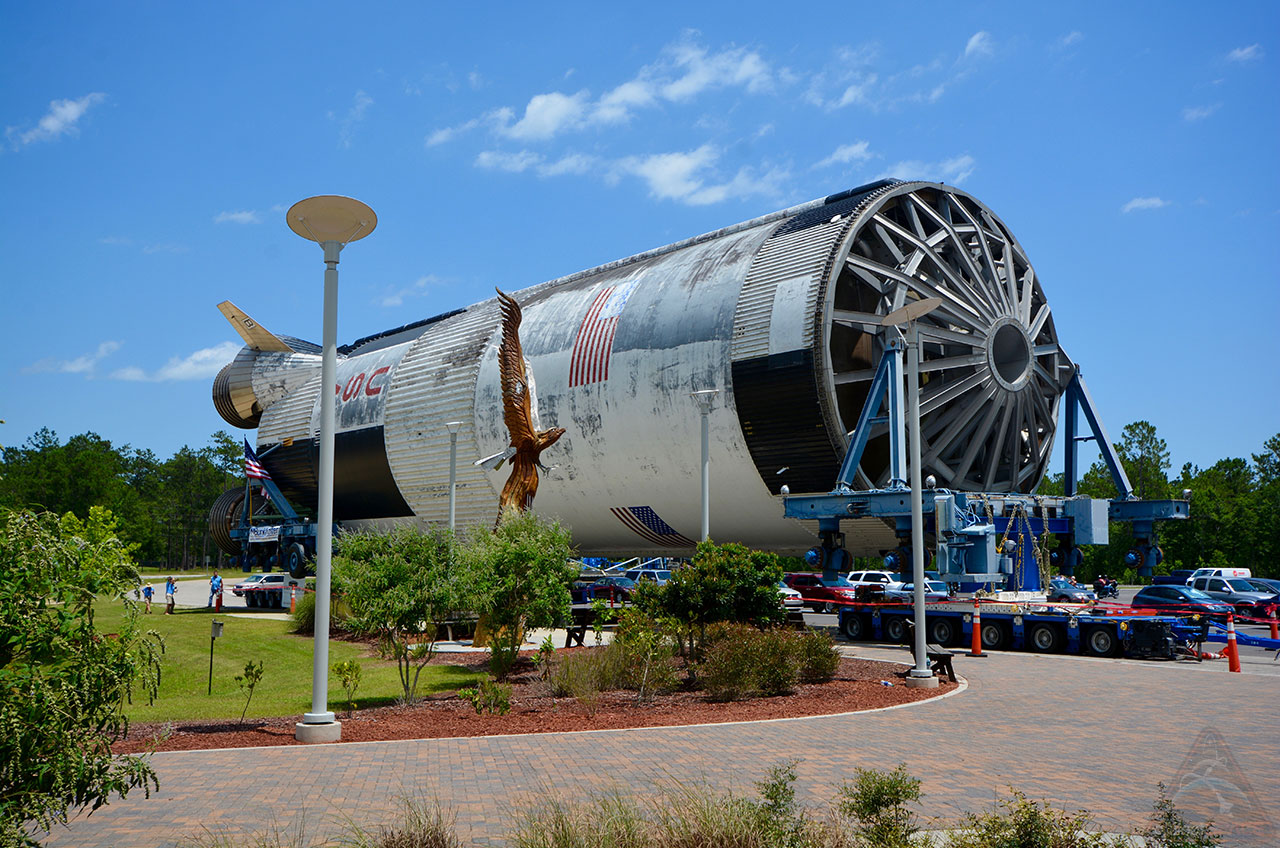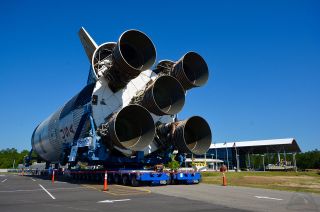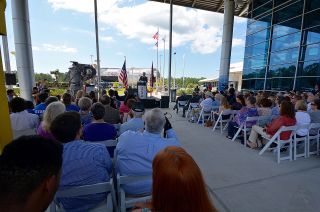Apollo 19 Saturn V Rocket Stage Arrives at Infinity Science Center

PEARLINGTON, MS — A massive, 40-year-old relic left over from NASA's Apollo moon program has landed a new mission as a roadside attraction on one of the United States' most traveled highways.
Drivers taking Interstate 10 to enter Mississippi from Louisiana on Tuesday (June 21) were the first to catch sight of the newly-delivered Saturn V first stage parked outside the Infinity Science Center, the visitor center for the nearby NASA Stennis Space Center in Pearlington, Mississippi.
The 138-foot-long (42 meter), 360-ton artifact was moved overnight from Stennis, in part rolling down the same stretch of the interstate it now sits beside. [Photo Gallery: Saturn V First Stage Arrives at Infinity Science Center]
"This is an incredible day," said astronaut Fred Haise, who was slated to fly atop the rocket stage until his Apollo 19 moon landing mission was canceled in 1970. "We have an incredible object behind me here."
Haise, who also missed landing on the moon as a crew member on the Apollo 13 mission, now helps lead the board of the Infinity Science Center. On Tuesday morning, he joined other center leaders, NASA officials and Mississippi Governor Phil Bryant celebrating the arrival of the stage at its new home.
"This is a great first step in preserving this priceless artifact for the generations to come," said Rick Gilbrech, Stennis' director.

The stage, which served as the "business end" of the Saturn V rocket — its five F-1 engines providing the tremendous thrust needed to lift the towering booster off the launch pad — arrived at Stennis on Friday (June 17), having traveled by barge from its birthplace and display site of 38 years, NASA's Michoud Assembly Facility in New Orleans.
Get the Space.com Newsletter
Breaking space news, the latest updates on rocket launches, skywatching events and more!
"It is a bittersweet day," said Bobby Watkins, the director of Michoud. "The folks at Michoud, even though they are disappointed, realize this is the right thing to do."
"[We] look towards the possibilities of inspiring the next generation by seeing this particular asset being restored to its rightful place in history," he said.
This is not the first time this stage, referred to as S-IC-15, made the journey from Louisiana to Mississippi.
"For Stennis, this stage is no stranger to our site," said Gilbrech. "We tested it 46 years ago and belched out 7.5 million pounds of thrust in our rocket test stand. Then it went back to Michoud and queued for its next mission, the Apollo program ended and it was put on display out there."
Four decades of exposure to the elements — including Hurricane Katrina in 2005 — have left the S-IC in poor condition. Its iconic black and white roll pattern has given way to bare grey metal and green mold.

"As you can see, it is going to take more than a couple of little cans of touch-up paint to spruce this baby up," Gilbrech said.
"We will take good care of it, we will spruce it up and we will shine it and will make it proud for everyone to look at," stated John Wilson, the executive director of the Infinity Science Center.
The state underwrote the expense of moving the stage to Mississippi, but it will be up to Wilson and his staff at the science center to raise the funds needed for the restoration and the construction of a building to protect and properly display the S-IC. The science center is now accepting donations through its website, offering a souvenir Apollo 19 patch signed by Haise for contributions of $150 or more.
In the meantime, the center has built up an outdoor "landing pad" for the Saturn V first stage, positioning it so that its eye-catching F-1 engines point out toward the interstate. The hope is that the exhibit will encourage drivers to stop by and learn more about the role that Mississippi and the surrounding area has played and continues to play in NASA's space exploration efforts.
"That is what this day is all about," said Wilson. "It is about standing up this artifact as a vessel and instrument of inspiration."
"We are in the business of building the next generation of Americans who can go build that type of stuff, and build it here in Mississippi and next door in Louisiana and amongst our neighbors elsewhere," he said.
See more photographs of the Saturn V first stage being moved to the Infinity Science Center at collectSPACE.com.
Follow collectSPACE.com on Facebook and on Twitter at @collectSPACE. Copyright 2016 collectSPACE.com. All rights reserved.
Join our Space Forums to keep talking space on the latest missions, night sky and more! And if you have a news tip, correction or comment, let us know at: community@space.com.

Robert Pearlman is a space historian, journalist and the founder and editor of collectSPACE.com, an online publication and community devoted to space history with a particular focus on how and where space exploration intersects with pop culture. Pearlman is also a contributing writer for Space.com and co-author of "Space Stations: The Art, Science, and Reality of Working in Space” published by Smithsonian Books in 2018. He previously developed online content for the National Space Society and Apollo 11 moonwalker Buzz Aldrin, helped establish the space tourism company Space Adventures and currently serves on the History Committee of the American Astronautical Society, the advisory committee for The Mars Generation and leadership board of For All Moonkind. In 2009, he was inducted into the U.S. Space Camp Hall of Fame in Huntsville, Alabama. In 2021, he was honored by the American Astronautical Society with the Ordway Award for Sustained Excellence in Spaceflight History.
